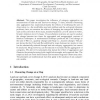Free Online Productivity Tools
i2Speak
i2Symbol
i2OCR
iTex2Img
iWeb2Print
iWeb2Shot
i2Type
iPdf2Split
iPdf2Merge
i2Bopomofo
i2Arabic
i2Style
i2Image
i2PDF
iLatex2Rtf
Sci2ools
GISCIENCE
2004
Springer
2004
Springer
Effect of Category Aggregation on Map Comparison
This paper investigates the influence of category aggregation on measurement of land-use and land-cover change. To date, research concerning data aggregation has examined primarily the effects of modifying the unit of observation (i.e., the modifiable areal unit problem and the ecological inference problem); here, we examine the effects of changing the categorical definition, such as the conversion from many, detailed Anderson Level II classes to fewer, broader Anderson Level I classes. Cross-tabulation matrices are used to analyze the change between two times for aggregated and unaggregated versions of identical landscapes. A mathematical technique partitions the Total change as the sum of Net (i.e., quantity change) and Swap (i.e., location change). This paper shows that the Total and Net exhibited by maps between two points in time can be substantially reduced through land-use category aggregation, but cannot be increased. Swap, however, can be reduced or increased by the aggregatio...
Category Aggregation | GIS | GISCIENCE 2004 | Land-use Category Aggregation | Modifiable Areal Unit Problem |
| Added | 01 Jul 2010 |
| Updated | 01 Jul 2010 |
| Type | Conference |
| Year | 2004 |
| Where | GISCIENCE |
| Authors | Robert Gilmore Pontius Jr., Nicholas R. Malizia |
Comments (0)

